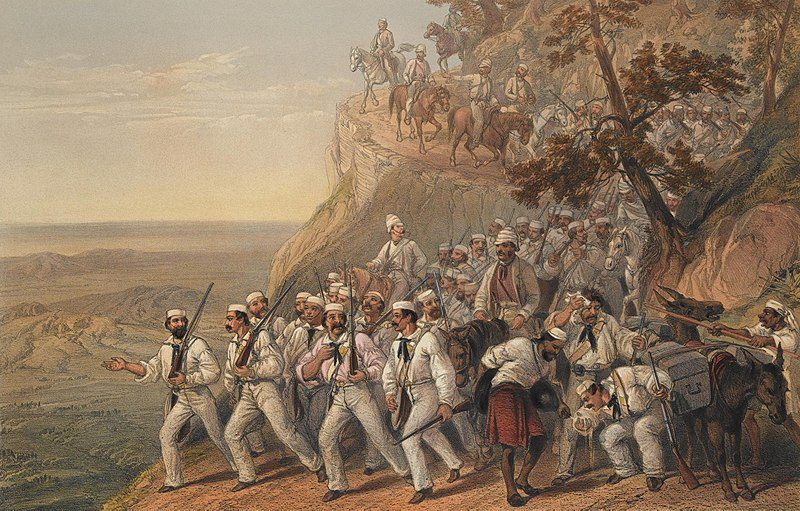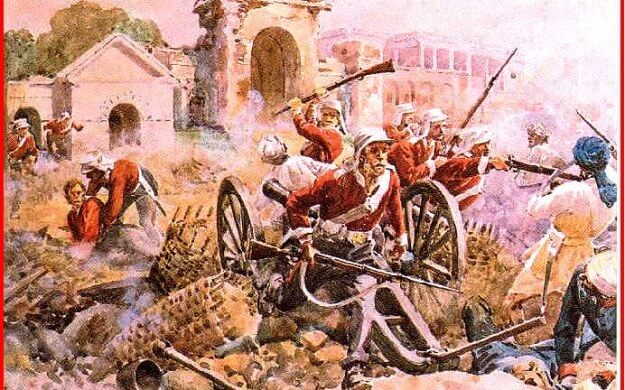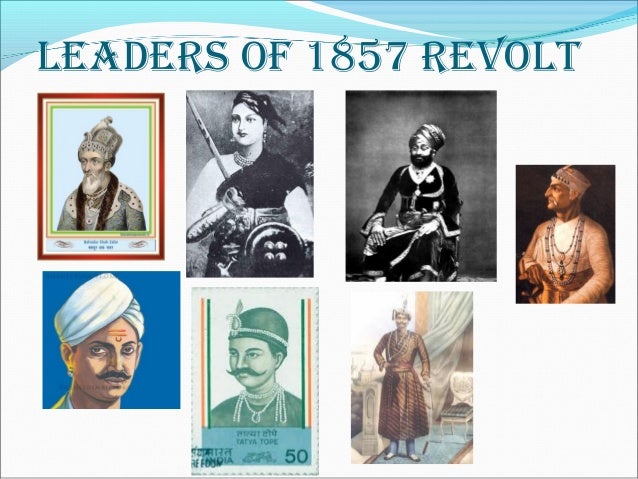India was under British rule for 200 years. The fight for independence was not easy and certainly not won in a day. Many revolts were won & lost which led to the moment of independence for India. One of the major revolts was the Sepoy Mutiny also known as the Revolt of 1857 or the Indian Revolution of 1857. In this blog, you will learn about the revolt of 1857, its causes & failures and how it became the harbinger of other Indian National Movements. The revolt started on the 10th of May 1857, by sepoys in Meerut. The revolt lasted for a year but was unsuccessful. Furthermore, India needed certain peaceful changes and this revolution brought her that. A major highlight of this revolt was that it abolished the East India Company’s rule in India. Additionally, central and northern parts of India took part in the Revolt of 1857 and various reasons bundled up the Indians.
NCERT Class 7 History: Chapter 8 Eighteenth-century Political Formations (Free PDF)
This Blog Includes:
- Timeline of the Revolt of 1857
- Political Causes
- Economic Causes
- Military Causes
- Social Causes
- Centres of the Revolt of 1857
- The Suppression and the Revolt of 1857
- Historical Movements of the Revolt of 1857
- Who Opposed the Revolt of 1857?
- Failure of the Revolt of 1857
- Leaders of the Revolt of 1857
- List of British Officials
- The Aftermath of the Revolt of 1857
- Best Books related to the Revolt of 1857
- Short Note on Revolt of 1857
- Important Questions on the Revolt of 1857
- FAQs
Timeline of the Revolt of 1857
The Timeline of the Revolt of 1857 is as follows:
| Importan t Dates | Events During the Revolt of 1857 |
| February 1857 | Sepoys of the 19th Native Infantry refused to use rifles. |
| March 1857 | The Native Infantry disbanded after Mangal Pandey injures 2 British soldiers. |
| April 1857 | Mangal Pandey is hanged and troops at Meerut refused to use greased cartridges. |
| May 1857 | Unrest in Ambala, troops slaughter Europeans and Christians as they reach Delhi. Bahadur Shah II was proclaimed as the Mughal ruler in Delhi. Jhansi state was captured by rebels and handed over to Rani of Jhansi. |
| June 1857 | Mutinies in Lucknow, Bhurtpore and Rohilkhand started. |
| July 1857 | Unrest in the entire country. Nana Sahib was defeated in the first battle of Cawnpore. Lord Canning issued his ‘Clemency’ resolution stating that mutineers who aren’t convicted of murder should not be hanged. |
| September 1857 | Delhi captured and cleaned of rebel groups. |
| November 1857 | Kavanaugh escaped from Lucknow. Children and Women evacuated from Lucknow. British withdraw from Lucknow. |
| December 1857 | Tantia Tope was defeated in the third battle of Cawnpore. |
| April 1858 | Jhansi was captured by the British. |
| June 1858 | Battle of Gwalior and Rani of Jhansi’s death. |
| August 1858 | Queen Victoria transferred the authority of India from the East India Company to the Crown. |
| April 1859 | Tantia Tope was executed after being found guilty of betrayal. |
| July 1859 | Peace declared. |
Causes of the Indian Revolt of 1857
There were numerous Political, Economic, Military as well as Social Causes that led to the Revolt of 1857, read below to know more!
Political Causes
The Political Causes of the Revolt of 1857 were:
- The uprising’s political roots can be attributed to Britain’s expansionist strategy, characterized by the Doctrine of Lapse and the Practice of Direct Annexation.
- Numerous Indian rulers and leaders experienced displacement, instilling apprehension among other ruling clans who feared facing a comparable destiny.
- Rani Lakshmi Bai’s adopted son faced the prohibition of ascending the throne of Jhansi.
- The Doctrine of Lapse led to the annexation of Satara, Nagpur, and Jhansi.
- Additionally, Jaitpur, Sambalpur, and Udaipur were also subjected to annexation.
- Lord Dalhousie’s annexation of Awadh, justified by allegations of maladministration, resulted in the displacement of numerous nobles, officials, retainers, and soldiers.
- This action transformed Awadh, previously a loyal state, into a breeding ground for discontent and intrigue.
Economic Causes
The Economic Causes of the Revolt of 1857 were as follows:
- In the rural regions, farmers and landowners expressed strong dissatisfaction with the substantial land taxes and rigorous revenue collection methods imposed by the East India Company.
- Many individuals within these communities found it challenging to meet the high revenue requirements and settle their debts with moneylenders, resulting in the eventual loss of ancestral lands.
- A significant portion of the sepoys, who were part of the peasantry, shared familial connections with the villages.
- Consequently, the grievances faced by the rural population had a direct impact on the sepoys as well.
- The discontent among peasants and landowners created a ripple effect, influencing the sentiments of the sepoys.
- Following the Industrial Revolution in England, there was a surge in the introduction of British-manufactured goods to India.
- This influx had detrimental effects on various industries, notably the textile sector in India.
- The indigenous handicraft industries in India were compelled to contend with inexpensive machine-made products from Britain, leading to a decline in their economic viability.
Military Causes
The Military Causes of the Revolt of 1857 were:
- The uprising of 1857 commenced as a rebellion among the Indian sepoys.
- Comprising over 87% of the British military forces in India, these sepoys faced discriminatory treatment in comparison to their British counterparts.
- Despite holding the same rank, Indian sepoys received lower pay than their European counterparts.
- Furthermore, they were obligated to serve in distant regions, far from their homes.
- Adding to their grievances, in 1856, Lord Canning implemented the General Services Enlistment Act, mandating that sepoys must be prepared to serve even in British territories beyond the seas.
The Social Causes of the Revolt of 1857 are as follows:
- The swift diffusion of Western Civilization in India raised widespread concerns throughout the nation.
- An 1850 legislation altered the Hindu law of inheritance, allowing a Hindu who had embraced Christianity to inherit ancestral properties.
- This change fueled suspicions among the populace, leading many to believe that the government had intentions of converting Indians to Christianity.
- The abolition of customs such as sati and female infanticide, along with the enactment legalizing widow remarriage, was perceived as a menace to the established social structure.
- The introduction of Western methods of education directly challenged the traditional beliefs of both Hindus and Muslims.
- Additionally, the arrival of railways and telegraph systems was met with scepticism, further contributing to the apprehension surrounding the impact of Western influence in the country.
Also Read: What is the Golden Revolution?
The Immediate Cause of the Revolt of 1857
The Revolt of 1857 ultimately originated from the controversy surrounding the use of greased cartridges.
- A rumour circulated that the cartridges for the recently introduced Enfield rifles were coated with animal fat from cows and pigs.
- Sepoys, before loading these rifles, had to bite off the paper on the cartridges, hence leading to the refusal of both Hindu and Muslim sepoys to utilize them.
Despite attempts by Lord Canning to rectify the mistake by withdrawing the offending cartridges, the damage had already been done, sparking unrest in various regions.
- In March 1857, Mangal Pandey, a sepoy stationed in Barrackpore, rejected the use of the controversial cartridge and assaulted his senior officers.
- He was subsequently executed on the 8th of April.
- On the 9th of May, 85 soldiers in Meerut also refused to employ the new rifles and were consequently sentenced to ten years of imprisonment.
Also Read: Third Carnatic War: Causes, Battles and Impact

What Were the Effects of the Revolt of 1857 on India?
The revolt of 1857 was not a success but created a huge impact on India. The major impact was the abolishment of the East India Company, India was under the direct control of British authority, The Indian administration was directly controlled by queen victoria. The second impact that the revolt of 1857 created was to develop unity & patriotism in the nation. Press was restricted since the Revolt of 1857 involved the Peasants as well. The press played an important role in the freedom struggle. It helped to educate Indians, influence them & aware of government policies.
Centres of the Revolt of 1857
The revolt spread over the entire area from the neighbourhood of Patna to the borders of Rajasthan. Additionally, the main centres of revolt, commonly known as the sepoy mutiny in these regions namely Kanpur, Lucknow, Bareilly, Jhansi, Gwalior, and Arrah in Bihar.
- Lucknow: It was the capital of Awadh. Begum Hazrat Mahal, one of the begums of the ex-king of Awadh, took up the leadership of the revolt.
- Kanpur: The revolt was led by Nana Saheb, the adopted son of Peshwa Baji Rao II.
- He became a participant in the uprising mainly due to the British withholding his pension.
- The triumph proved to be fleeting as Kanpur fell back into British hands with the arrival of additional troops.
- Furthermore, the rebellion faced a brutal suppression, marked by merciless retribution.
- While Nana Saheb managed to evade capture, his skilled strategist Tantia Tope persisted in the fight.
- However, Tantia Tope was ultimately overcome, apprehended, and executed.
- Jhansi: The twenty-year-old Rani Lakshmi Bai led the rebels when the British refused to accept the claim of her adopted son to the throne of Jhansi.
- Consequently, she bravely resisted the British forces but, in the end, succumbed to the English adversaries.
- Bihar: The revolt was led by Kunwar Singh who belonged to the royal house of Jagdispur, Bihar.
- Gwalior: Following Rani Lakshmi Bai’s successful escape, she joined forces with Tantia Tope, embarking on a march towards Gwalior, ultimately conquering the city.
- The ensuing battle witnessed the Rani of Jhansi displaying remarkable courage, akin to a tigress in combat, until her demise in the thick of the struggle.
- Unfortunately, the British managed to reclaim Gwalior after the fierce encounter.
Also Read: Important Revolutions in India You Must Know About
The Suppression and the Revolt of 1857
The uprising of 1857 extended beyond a year before being quelled by mid-1858. On the 8th of July 1858, Lord Canning declared peace, concluding the tumultuous events that began in Meerut fourteen months earlier.
| Significant Places of Revolt of 1857 | Indian Leaders of the Revolt of 1857 | British Officials that Suppressed the Revolt of 1857 |
| Lucknow | Begum Hazrat Mahal | Henry Lawrence |
| Kanpur | Nana Saheb | Sir Colin Campbell |
| Gwalior and Jhansi | Tantia Tope and Lakshmi Bai | General Hugh Rose |
| Bihar | Kunwar Singh | William Taylor |
| Delhi | Bahadur Shah II | John Nicholson |
| Allahabad and Banaras | Maulvi Liyakat Ali | Colonel Oncell |
| Bareilly | Khan Bahadur Khan | Sir Colin Campbell |
Historical Movements of the Revolt of 1857
Additionally, there were many historical movements during the Revolt of 1857 which are still the centres of conversations when we talk about our Independence struggle.
- Mangal Pandey– Mangal Pandey did not just refuse to use cartridges greased with cow or pig fat, he created an uproar within his Infantry which led to injuring the British generals. His bravery is unmatched to date though he was hanged by the East India Company.
- Cawnpore Massacre– Cawnpore or Kanpur was the highlight of the Revolt of 1857. When Cawnpore was sieged by the sepoys, they allowed the British rescue party to travel to Allahabad through Cawnpore. However, the British soldiers and civilians (including 120 women and children) were killed by the sepoys. This enraged the East India Company who tortured, looted the Indian civilians and executed a large number of sepoys in Cawpore and recaptured the city.
- Rani of Jhansi’s historic win– Rani Laxmibai refused the East India Company to annex Jhansi. The British forces then slowly marched towards Jhansi. It was in the darkness of the night that the rebels attacked the fort where the British leaders and their servants were resting and killed all of them.
Who Opposed the Revolt of 1857?
You will be surprised to know that a lot of the Indian communities didn’t support the Revolt of 1857. While more than a quarter of the native soldiers were Muslims, the Ulemas of the community did not support or believe that military violence was required against the East India Company.
Furthermore, a lot of important Sikhs and Pathan leaders in the Punjab province sided and conspired with the East India Company as they feared that if the Revolt drove out the British, the Mughals would come to power.
Gwalior was one of the centres of rebellion by the sepoys and civilians yet the state’s ruler, Jayaji Rao Scindia supported the British.

Failure of the Revolt of 1857
The revolt was an extraordinary event in Indian history, but the result of the revolt was unsuccessful due to some major drawbacks. Here are all the reasons for the failure of the revolt of 1857:
- Constrained Uprising: While the rebellion exhibited a certain degree of diffusion, a substantial portion of the nation remained unaffected by its influence.
- The insurgence was predominantly confined to the Doab region, with notable exceptions in the large princely states of Hyderabad, Mysore, Travancore, and Kashmir, alongside the smaller ones in Rajputana, abstaining from participation.
- Additionally, the southern provinces refrained from engaging in the rebellion.
- Absence of Effective Leadership: The insurgents grappled with a lack of proficient leadership.
- In addition, despite the bravery of figures such as Nana Saheb, Tantia Tope, and Rani Lakshmi Bai, their leadership failed to provide the necessary direction to the entire movement.
- Resource Constraints: The rebels faced notable deficiencies in terms of manpower and financial support. In contrast, the English authorities received a consistent influx of reinforcements, funds, and weaponry within India.
- Exclusion of the Middle Class: The English-educated middle class, affluent merchants, traders, and landowners in Bengal actively supported the British in quelling the rebellion, as they opted not to participate in the insurrection.
Also Read: What is Blue Revolution?

Leaders of the Revolt of 1857
Many leaders took part in the Revolt of 1857, here are all the leaders:
| Place | Leaders of the Revolt of 1857 | ||
| Lucknow | Begum Hazrat Mahal, Birjis Qadir, Ahmadullah | ||
| Delhi | Bahadur Shah II, General Bakht Khan | ||
| Barrackpore | Mangal Pandey | ||
| Bihar | Kunwar Singh, Amar Singh | ||
| Faizabad | Maulvi Ahmadullah | ||
| Jhansi | Rani Laxmibai | ||
| Bijnaur | Mohammad Khan | ||
| Allahabad & Banaras | Maulvi Liyakat Ali | ||
| Farrukhabad | Tufzal Hasan Khan | ||
| Muradabad | Abdul Ali Khan | ||
| Kanpur | Tantia Tope | ||
| Mandsor | Firoz Shah | ||
| Rajasthan | Jaidayal Singh and Hardayal Singh | ||
| Kullu | Raja Pratap Singh | ||
| Assam | Kandapareshwar Singh, Manorama Datta | ||
| Orissa | Surendra Shahi, Ujjwal Shahi | ||
| Gorakhpur | Rajadhar Singh |

List of British Officials
The List of British Officials:
- General John Nicholson
- Major Hudson
- Sir Hugh Wheeler
- General Neil
- Sir Colin Campbell
- Henry Lawrence
- Major General Havelock
- William Taylor and Eye
- Hugh Rose
- Colonel Oncell
White Revolution, The Story of India’s Milk Revolution
The Aftermath of the Revolt of 1857
The Results of the Revolt of 1857 were:
- End of Company Rule: The revolt marked the end of the East India Company’s rule in India
- The direct rule of the British Crown: India came under the direct rule of the British Crown. This was announced by Lord Canning at a Durbar in Allahabad in a proclamation issued on November 1, 1858, in the name of the queen.
- Religious Tolerance: The British Crown promised religious tolerance and the customs and traditions of India were given more attention.
- Administrative Change: The governor general’s office was replaced by that of the Viceroy.
- Military Reorganisation: The ratio of British officers to Indian soldiers increased but the armoury remained in the hands of the English to end the dominance of the Bengal army.
Here are some books you can dig into for more details on the Revolt of 1857.
- Religion and Ideology of the Rebels of 1857 by Iqbal Hussain
- Rebellion, 1857: A Symposium by Puran Chand Joshi
- Great Mutiny by Christopher Hibbert
- Facets of the Great Revolt 1857
- The Indian War of Independence by Vinayak Damodar Savarkar
- Awadh in Revolt, 1857-1858 by Rudrangshu Mukherjee
- The Indian Mutiny: 1857 by Saul David
Short Note on Revolt of 1857
The Revolt of 1857 was first started on May 10, 1857, by sepoy mutiny in Meerut. The revolt lasted for a year and was unsuccessful yet it brought the changes that India needed for years. A major highlight of this revolt was that it abolished the East India Company in India. Central & northern parts of India took part in the revolt of 1857. There were various reasons that bundled up the Indians. It was also known as the Sepoy Mutiny, the Indian Mutiny and the Great Rebellion. The main outcome of the revolt in 1857 was the end of company rule in India and the establishment of direct rule of the British Crown.
Download Social Science Class 7 History Chapter 8 Important Questions and Answers PDF
The revolt of 1857 was an unprecedented event in the history of British rule in India. It united, though in a limited way, many sections of Indian society for a common cause. Though the revolt failed to achieve the desired goal, it sowed the seeds of Indian nationalism.
Important Questions on the Revolt of 1857
Why were the powers of the East India Company transferred to the British Crown?
Post the sepoy mutiny, the powers of East India Company were transferred because the company rule was ended in India after the revolt.
How did the position of governor-general change after the revolt of 1857?
The governor-general was given the title of a viceroy who became a personal representative of the crown.
How was the revolt suppressed by the British?
The company decided to regain control over its lost territories and suppressed the revolt in complete retaliation.
What was the role of Mangal Panday in the revolt of 1857?
Mangal Panday was a young soldier stationed in the British army at Barrackpore refused to use the rifle and attacked his British officers.
Check out Class 6 History Notes:
Relevant Blogs
FAQs
There was a change in rifle, Sepoys had to tear the cartridges with their mouths & it was greased with cow & pig fat. The sepoys were also sentenced when they rejected the rifles & cartridges.
The revolt of 1857 lasted for a year.
Yes, Mangal Pandey was among the leaders of the revolt of 1857.
Yes, Rani Laxmi bai adopted a son & after the doctrine of lapse only the true & natural male heir was allowed to rule.
There were political, social, religious & military causes that resulted in the revolt of 1857.
Yes, the revolt of 1857 is considered the first war of independence.
We hope you liked our blogon the Revolt of 1857. If you want to read more articles like this, you can get Short notes on the Modern History of India here. Also, you can visit our general knowledge page on Indian History! The Revolt of 1857 is one of the topics covered in government exams & UPSC as well. Read about such informative blogs on Leverage Edu and stay informed about Indian history.
-
What was the impact of revolt of 1857??
-
Hi Tanu!
The main impact of the 1857 revolt was the abolishment of the East India Company, India was under the direct control of British authority, The Indian administration was directly controlled by queen victoria. The second major impact that the revolt of 1857 created was to develop unity & patriotism among the nation.
Hope this answers your question!
-
-
Thanks for giving the information. It was helpful for my board project 🙏😊
-
Hi, Keerthana! We are glad you found it useful.
Here you can also check some of our top reads: Decoding the Battle of Plassey of 1757!
Battle of Buxar: Significance, Causes and Aftermath
Indian Freedom Fighters
-

 One app for all your study abroad needs
One app for all your study abroad needs





















 45,000+ students realised their study abroad dream with us. Take the first step today.
45,000+ students realised their study abroad dream with us. Take the first step today.


5 comments
What was the impact of revolt of 1857??
Hi Tanu!
The main impact of the 1857 revolt was the abolishment of the East India Company, India was under the direct control of British authority, The Indian administration was directly controlled by queen victoria. The second major impact that the revolt of 1857 created was to develop unity & patriotism among the nation.
Hope this answers your question!
Thanks for giving the information. It was helpful for my board project 🙏😊
Hi, Keerthana! We are glad you found it useful.
Here you can also check some of our top reads: Decoding the Battle of Plassey of 1757!
Battle of Buxar: Significance, Causes and Aftermath
Indian Freedom Fighters
1857 Revolt write a summary